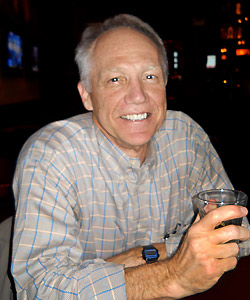 Nearly 40 years ago, when he was studying for the bar exam and delivering phone books to make a living, Richard Babcock used to drop by John Barleycorn, the Lincoln Park tavern that opened in 1963 at 658 West Belden Avenue. Now here he is in 2012 sipping a Glenlivet single malt Scotch in the same establishment, which happens to figure in his new novel, Are You Happy Now? Due out Tuesday from Amazon Publishing, it tells the story of John Lincoln, a Chicago book editor seeking the breakthrough title that will untether him from the bland Midwest and launch him into the big leagues of New York City.
Nearly 40 years ago, when he was studying for the bar exam and delivering phone books to make a living, Richard Babcock used to drop by John Barleycorn, the Lincoln Park tavern that opened in 1963 at 658 West Belden Avenue. Now here he is in 2012 sipping a Glenlivet single malt Scotch in the same establishment, which happens to figure in his new novel, Are You Happy Now? Due out Tuesday from Amazon Publishing, it tells the story of John Lincoln, a Chicago book editor seeking the breakthrough title that will untether him from the bland Midwest and launch him into the big leagues of New York City.
The editor-in-chief at Chicago from 1991 to 2011, Babcock began the novel while still at the magazine. “I wanted to explore ideas of ambition, the nature of work and happiness,” he says, explaining the book’s genesis. “After all, that’s set out in our founding documents: the pursuit of happiness. It’s a nutty concept—but so American.”
Toward that end, he followed his usually methodology: “creating characters and turning them loose, not sure where they’re going to go.” Those characters include Tony Buford, an African American professor (of happiness) at DePaul who’s also a would-be poet and potential blackmailer; Amy O’Malley, the University of Chicago English grad whose fictional, sexy tell-all, The Ultimate Position, might be Lincoln’s ticket out of town; and Benjamin Flam, the Chicago Tribune literary editor who joins Lincoln for cocktails, cheeseburgers, and conversation at John Barleycorn. As in so much good many American writing (think William Faulkner and John Irving), there is also a bear—in this case, a wrestling bear.
In 1988, Babcock’s first novel, Martha Calhoun, explored small-town Illinois; in his second novel, Bow’s Boy (2002), the Woodstock native looked at small-town Wisconsin. This time around he’s provided an open-eyed, at times celebratory portrait of Chicago. Against this familiar setting, Babcock’s characters find their destinies and, as his surrogates, explore notions of ambition and happiness and the nature of modern culture, which includes e-texts and bloggers. “‘These days, everybody’s a writer,’” says Babcock, sipping his Scotch and quoting his character Flam, “and there are good things about that and bad things about that.” His novel looks at both sides of that coin. It also extols a profession with which Babcock is well acquainted: that of editor—a person whose job, after all (as John Lincoln reminds us), is to make things better.
Photograph: Geoffrey Johnson



